火烧油层是指通过注入井向油层注入空气,然后以空气中的氧气为助燃剂使油层中部分原油燃烧,利用燃烧产生的热量改变油层条件和原油物性,进而将未燃烧区原油采出的一种稠油热采方式[1-3]。火烧油层一般需要人工点火,而常用的人工点火方式是电点火,但电点火存在点火温度过高(点火温度超过380 ℃)、成功率较低等问题[3]。因此,人们开始研究和应用化学点火。化学点火是将化学剂注入油层,并在高温热流体作用下发生化学放热反应,从而点燃原油的一种点火方式。在化学点火中,降低点火温度、提高点火的成功率依然是目前探索的方向。为此,结合实践经验,笔者引入自蔓燃技术,提出了自蔓燃的化学点火方式,期望利用材料的自蔓延燃烧特性,在外界较低初始能量的作用下实现自蔓燃,产生高热量,从而点燃油层。
经初步研究,筛选出了自蔓燃材料,主要以羧酸、羧酸盐、尿素及肼类含氮有机物等有机化合物为燃料,以金属硝酸盐为氧化剂[4-9]。将该燃料和氧化剂的饱和水溶液加热浓缩,会起火燃烧,且能够长时间维持火焰。其原理是,这些自蔓燃材料在很短时间内借助外界能量开始燃烧,使大量的有机物迅速发生氧化-还原反应,同时迅速将热量传递给与之邻近的未反应物,使其温度升高直至达到燃点从而使反应得以自维持[10]。基于此,笔者用自蔓燃材料作为点火剂,进行了化学点火物理模拟研究,以期为火烧油层提供一种低温点火、高温燃烧的新途径。
1 自蔓燃点火方法 1.1 试剂与仪器试验所用试剂主要有:取自于胜利油田某区块的原油,0号柴油,硝酸铵,柠檬酸,以及自制助剂。以上试剂均为分析纯。
试验用仪器主要有FA2004N电子天平、DV-Ⅲ旋转黏度计、火烧油层模拟试验装置等。其中,火烧油层模拟试验装置如图 1所示(图 1中,T1,T2,…,T14为测温热电偶编号)。

|
| 图 1 火烧油层模拟试验装置示意 Fig.1 Simulation device of in-situ combustion |
室温下,将硝酸铵与柠檬酸以质量比5:12混合并溶解于500 mL蒸馏水中,加入5.00 g助剂,充分搅拌溶解,然后置于105 ℃左右的烘箱中,干燥至溶液变为凝胶状,将烘箱温度降至40 ℃,继续干燥使其呈块状,然后冷却,再粉粹至一定粒径,密封,备用。
1.3 模拟岩心的制备按文献[11]中的方法制备模拟岩心,制备步骤为:1)将1 950 g油砂从上端填入陶瓷岩心管中,边填边用有机玻璃棒压实,从岩心管的最下端(第14个测温点, 即T14所在处)填至第4个测温点(T4所在处)时停止,然后装入点火剂和油砂的混合物;2)从上到下依次插入14个测温热电偶;3)将陶瓷岩心管加盖密封,模拟岩心制备完成,将其固定,并放入恒温箱中,在60 ℃下放置24 h后备用[11-13]。
1.4 点火操作设定电炉温度为200 ℃,升温速度为5 ℃/min,空气初始流量为6 m3/(h·m2),设定上述参数后进行点火。当点火剂自燃后停止给电炉加热,点火剂燃烧至T4时,空气流量由初始的6 m3/(h·m2)调高至10 m3/(h·m2)。实时记录各个测温点的温度以及最高燃烧温度。燃烧结束后,冷却至室温,打开火烧油层模拟试验装置,测量原油被完全燃烧了的岩心段的长度。
选择不同粒径的石英砂和不同黏度的原油,通过改变石英砂、原油和水的质量比,制备不同渗透率、孔隙度、含油饱和度及含水率的模拟岩心,进行重复试验,研究不同模拟岩心条件下的点火温度(T1的自燃温度)和岩心燃烧情况[14-16]。
2 模拟试验及结果分析 2.1 原油黏度对模拟岩心燃烧的影响图 2所示为点火温度、最高燃烧温度(14个测温点中最高的燃烧温度)与原油黏度的关系曲线,图 3所示为燃烧程度(从开始端到结束处岩心中原油完全燃烧的距离占岩心总长度的百分比)与原油黏度的关系曲线。图 2和图 3中,原油黏度均是在25 ℃下测得的。

|
| 图 2 点火温度、最高燃烧温度与原油黏度的关系曲线 Fig.2 Relationship curves between the ignition temperature, the highest combustion temperature and the oil viscosity |
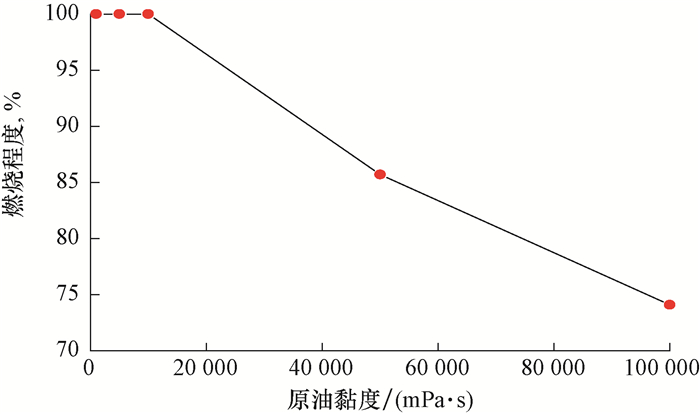
|
| 图 3 燃烧程度与原油黏度的关系曲线 Fig.3 Relationship curves between combustion degree and oil viscosity |
从图 2和图 3可以看出:1)点火剂的点火温度在100~200 ℃,随原油黏度升高而升高,原油黏度为1 000 mPa·s时点火温度为129 ℃,原油黏度为100 000 mPa·s时点火温度为154 ℃;2)原油的最高燃烧温度随原油黏度升高而降低,原油黏度为1 000 mPa·s时最高燃烧温度为710 ℃,原油黏度为100 000 mPa·s时,最高燃烧温度为620 ℃;3)原油黏度低于10 000 mPa·s时其燃烧程度为100%,当原油黏度为100 000 mPa·s时燃烧程度降低至74.1%。分析认为,原油黏度越高,点火剂颗粒表面的油膜强度越高,点火剂表面越不易与空气接触,因此点火温度越高;原油黏度越高,空气扩散速度越小,供应原油燃烧的氧气越少,最高燃烧温度越低,燃烧程度越低。
2.2 岩心孔隙度对模拟岩心燃烧的影响图 4所示为点火温度、最高燃烧温度与岩心孔隙度的关系曲线,图 5所示为燃烧程度与岩心孔隙度的关系曲线。
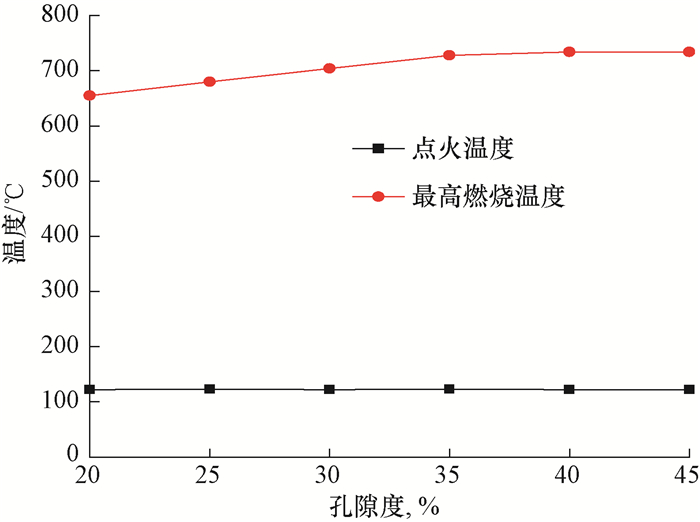
|
| 图 4 点火温度、最高燃烧温度与孔隙度的关系曲线 Fig.4 Relationship curves between the ignition temperature, the highest combustion temperature and the porosity |
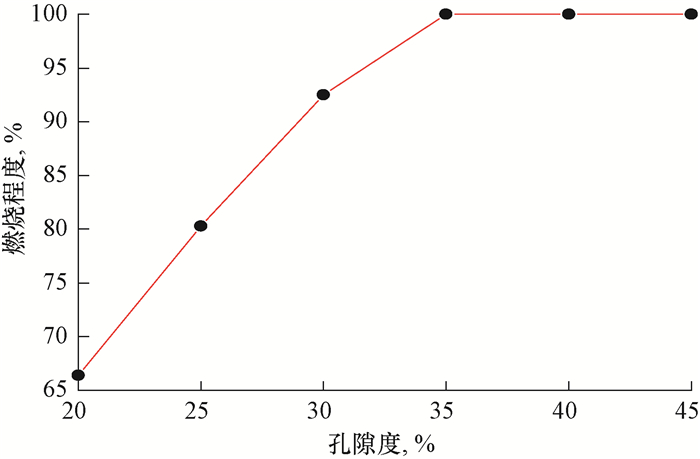
|
| 图 5 燃烧程度与孔隙度的关系曲线 Fig.5 Relationship curves between combustion degree and porosity |
从图 4和图 5可以看出,模拟岩心的孔隙度不影响点火剂的点火温度,但影响原油的燃烧程度和最高燃烧温度。分析认为:模拟岩心的孔隙度越大,燃烧越充分,孔隙度大于35%后原油燃烧程度达到100%;岩心的孔隙度越大,空气越容易扩散,原油燃烧时氧气供应充足,使原油燃烧更充分,因而燃烧温度也越高(最高可达734 ℃)。
2.3 含油饱和度对模拟岩心燃烧的影响试验用油砂是石英砂、原油和水的混合物,其中原油所占比例,也就是含油饱和度,对模拟岩心燃烧具有一定影响。因此,研究了点火温度、最高燃烧温度与含油饱和度的关系及燃烧程度与含油饱和度的关系,研究结果分别见图 6和图 7。
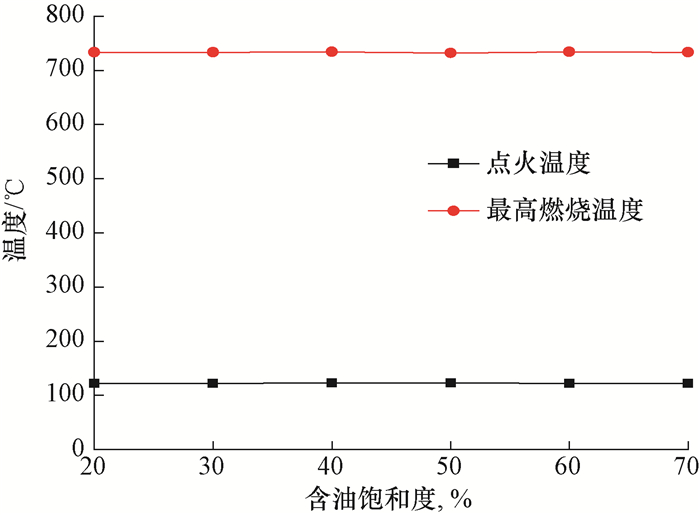
|
| 图 6 点火温度、最高燃烧温度与含油饱和度的关系曲线 Fig.6 Relationship curves between the ignition temperature, the highest combustion temperature and the oil saturation |
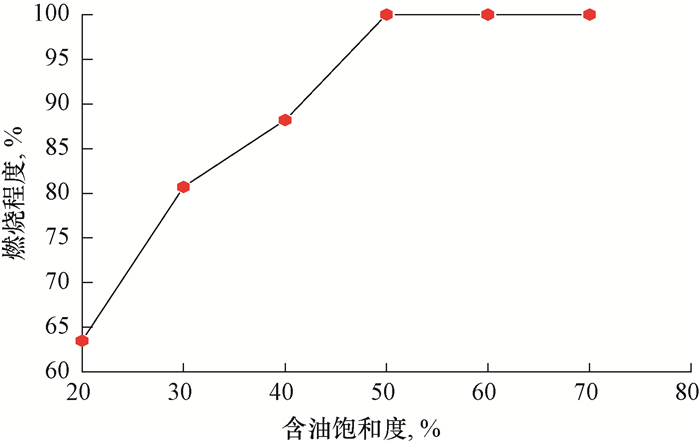
|
| 图 7 燃烧程度与含油饱和度的关系曲线 Fig.7 Relationship curves between combustion degree and oil saturation |
从图 6和图 7可以看出,模拟岩心的含油饱和度不影响点火剂的点火温度和原油的最高燃烧温度,但影响原油的燃烧程度。分析认为,这是因为含油饱和度越大,岩心中原油延续性越好,越不容易断火。在岩心孔隙度为35%、原油含水率为10%的条件下,模拟岩心的含油饱和度大于50%,原油燃烧程度为100%。
2.4 原油含水率对模拟岩心燃烧的影响试验用原油未经过脱水处理,因此其中具有一定量的乳化水,该乳化水体积含量即为原油含水率。研究了点火温度、最高燃烧温度与原油含水率的关系及燃烧程度与原油含水率的关系,结果分别见图 8和图 9。
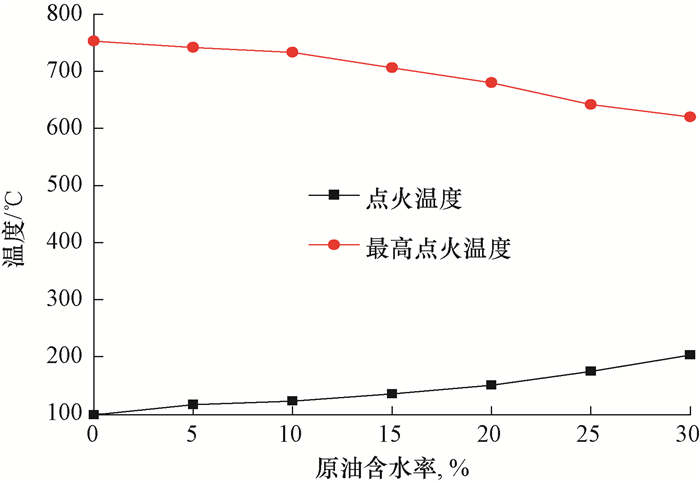
|
| 图 8 点火温度、最高燃烧温度与原油含水率的关系曲线 Fig.8 Relationship curves between the ignition temperature, the highest combustion temperature and the water saturation |

|
| 图 9 燃烧程度与原油含水率的关系曲线 Fig.9 Relationship curves between combustion degree and water content |
从图 8和图 9可以看出,原油含水率对模拟岩心中点火剂的点火温度、原油的最高燃烧温度和燃烧程度均有影响。分析认为,原油含水率越低,被水吸收的热量越少,越有利于点火剂的点燃,点火温度也越低(最低达98 ℃),燃烧温度越高(最高达753 ℃);含水率低于15%时原油的燃烧程度为100%,而含水率高于15%后原油不能充分燃烧,且随原油含水率升高燃烧程度降低。
3 结论与建议1) 研究的自蔓燃点火剂能够在较低温度(100~200 ℃,甚至可以低至98 ℃)下点燃原油,远低于目前常用的电点火温度(超过380 ℃),且室内试验点火成功率可达100%。
2) 点火温度、原油的最高燃烧温度和燃烧程度,受原油黏度、含水率、含油饱和度、岩心孔隙度的影响。点火温度与原油黏度和原油含水率正相关;原油的燃烧程度与孔隙度和含油饱和度正相关,与原油含水率负相关;最高燃烧温度与孔隙度正相关,与原油含水率负相关。
3) 自蔓燃点火使用非易燃易爆物质,且点火温度低、易操作,为火烧油层提供了一种安全、可靠的新点火方式。
4) 自蔓燃点火剂是具有一定粒径的固体,要在常温、干燥环境中储存,在现场实施时,要首先按一定比例与水溶性液体混合,配制成均匀液体,用泵正注入油层,再挤注隔离液段塞,然后注入热流体(热空气或蒸汽),把近井油层温度提高至120 ℃以上,然后按点火阶段设计的注气速度注气,点燃油层后进入正常火驱注气阶段。
| [1] |
朱海琦.
火驱电点火及其与其他点火方式的对比分析[J]. 内蒙古石油化工, 2014, 40(20): 58–59.
ZHU Haiqi. The comparison between fire-driven ignition and other ignition methods[J]. Inner Mongolia Petrochemical Industry, 2014, 40(20): 58–59. |
| [2] |
袁士宝, 孙希勇, 蒋海岩, 等.
火烧油层点火室内实验分析及现场应用[J]. 油气地质与采收率, 2012, 19(4): 53–55.
YUAN Shibao, SUN Xiyong, JIANG Haiyan, et al. Ignition experimental analysis of in-situ combustion under condition of preheating[J]. Petroleum Geology and Recovery Efficiency, 2012, 19(4): 53–55. |
| [3] |
谢志勤, 贾庆升, 蔡文斌, 等.
火烧驱油物理模型的研究及应用[J]. 石油机械, 2002, 30(8): 4–6.
XIE Zhiqin, JIA Qingsheng, CAI Wenbin, et al. Research and application of physical model of in-situ combustion[J]. China Petroleum Machinery, 2002, 30(8): 4–6. |
| [4] | PADYUKOV K L, LEVASHOV E A. Self-propagating high-temperature synthesis:a new method for the production of diamond-containing materials[J]. Diamond & Related Materials, 1993, 2(2/3/4): 207–210. |
| [5] | TANG Chenglong, ZHANG Yingjia, HUANG Zuohua. Progress in combustion investigations of hydrogen enriched hydrocarbons[J]. Renewable & Sustainable Energy Reviews, 2014, 30(2): 195–216. |
| [6] | SWITZER C, PIRONI P, GERHARD J I, et al. Self-sustaining smoldering combustion:a novel remediation process for non-aqueous-phase liquids in porous media[J]. Environmental Science & Technology, 2009, 43(15): 5871–5877. |
| [7] | WU Dejian, SCHMIDT M, HUANG Xinyan, et al. Self-ignition and smoldering characteristics of coal dust accumulations in O2/N2 and O2/CO2 atmospheres[J]. Proceedings of the Combustion Institute, 2017, 36(2): 3195–3202. DOI:10.1016/j.proci.2016.08.024 |
| [8] | TAO Mingyuan, HAN Dong, ZHAO Peng. An alternative approach to accommodate detailed ignition chemistry in combustion simulation[J]. Combustion and Flame, 2017, 176: 400–408. DOI:10.1016/j.combustflame.2016.11.009 |
| [9] | RESTUCCIA F, PTAK N, REIN G. Self-heating behavior and ignition of shale rock[J]. Combustion and Flame, 2017, 176: 213–219. DOI:10.1016/j.combustflame.2016.09.025 |
| [10] | LI Yao, ZHAO Jiupeng, JIANG Jiuxing, et al. Influence of oxygen pressure on combustion synthesis of ZnFe2O4[J]. Materials Chemistry and Physics, 2003, 82(3): 991–996. DOI:10.1016/j.matchemphys.2003.09.005 |
| [11] |
杨德伟, 王世虎, 王弥康, 等.
火烧油层的室内实验研究[J]. 石油大学学报(自然科学版), 2003, 27(2): 51–54.
YANG Dewei, WANG Shihu, WANG Mikang, et al. Experimental study on in-situ combustion[J]. Journal of the University of Petroleum, China(Edition of Natural Science), 2003, 27(2): 51–54. |
| [12] |
陈军斌, 肖述琴, 周芳德, 等.
火烧油层驱油特征的参数敏感性分析[J]. 应用力学学报, 2003, 20(1): 18–23.
CHEN Junbin, XIAO Shuqin, ZHOU Fangde, et al. The sensitivity analysis of parameters for in-situ combustion[J]. Chinese Journal of Applied Mechanics, 2003, 20(1): 18–23. |
| [13] |
关文龙, 蔡文斌, 王世虎, 等.
郑408块火烧油层物理模拟研究[J]. 石油大学学报(自然科学版), 2005, 29(5): 58–61.
GUAN Wenlong, CAI Wenbin, WANG Shihu, et al. Physical modeling research of in-situ combustion in Zheng-408 fireflood pilot[J]. Journal of the University of Petroleum, China(Edition of Natural Science), 2005, 29(5): 58–61. |
| [14] |
刘其成, 程海清, 张勇, 等.
火烧油层物理模拟相似原理研究[J]. 特种油气藏, 2013, 20(1): 111–114.
LIU Qicheng, CHENG Haiqing, ZHANG Yong, et al. Study on similarity principles of physical simulation of in-situ combustion[J]. Special Oil & Gas Reservoirs, 2013, 20(1): 111–114. |
| [15] |
蔡文斌, 谢志勤, 李友平, 等.
胜利王庄油田火烧驱油试验研究[J]. 石油天然气学报, 2005, 27(增刊2): 397–398.
CAI Wenbin, XIE Zhiqin, LI Youping, et al. Experiment of insitu combustion in Shengli Wangzhuang Oilfield[J]. Journal of Oil & Gas Technology, 2005, 27(supplement 2): 397–398. |
| [16] |
柴利文, 金兆勋.
中深厚层稠油油藏火烧油层试验研究[J]. 特种油气藏, 2010, 17(3): 67–69.
CHAI Liwen, JIN Zhaoxun. Pilot study of in situ combustion for mid-deep thick heavy oil reservoir[J]. Special Oil and Gas Reservoirs, 2010, 17(3): 67–69. |




